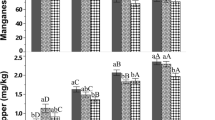Abstract
The residual effectiveness of copper (Cu) applied 18 to 21 years previously was estimated for grain yield of wheat. In one field experiment, current levels of Cu fertiliser were applied and its effectiveness was compared to that of the same level of Cu applied previously. The effects of nitrogen (N) fertiliser on the Cu concentration in the youngest emerged blade and in the grain, as well as the effects of N levels on the grain yield of wheat, were also studied.
Where the recommended level of Cu fertiliser had been applied previously, its residual effectiveness depended on the soil type. On the grey sands over clay and gravelly sands over clay, the residual Cu would last approximately 20 years where wheat is grown in rotation with a legume crop (Lupinus augustifolius L.) and where N fertiliser is applied at high levels (92 kg N ha−1). On the yellow brown sandy earths of the Newdegate district, the residual value was in excess of 30 years.
When Cu levels in the soil are marginal, high levels of N applied to wheat crops grown on stubbles of legume crops (high soil N) could suffer from induce Cu deficiency which could reduce grain production.
Critical concentrations of Cu in the youngest emerged blade of less than 1.2 mg Cu kg−1 at Gs50–59 would indicate Cu deficiency. Cu concentrations of less than 1.1–1.2 mg Cu kg−1 in the grain suggest that the wheat crop is marginally supplied with Cu. In both situations, Cu fertiliser needs to be applied before the next crop.
Similar content being viewed by others
References
Brennan RF, Gartrell JW and Robson AD (1980) Reactions of copper with soil affecting its availability to plants I. Effect of soil type and time. Aust J Soil Res 18: 447–459.
Brennan RF, Gartrell JW and Robson AD (1984) Reactions of copper with soil affecting its availability to plants III. Effect of incubation temperature. Aust J Soil Res 22: 165–172
Brennan RF, Robson AD and Gartrell JW (1986) The effect of successive crops of wheat on the availability of Cu fertiliser to plants. Aust J Agric Res 37: 115–124
Brennan RF (1990) Effectiveness of some copper compounds applied as foliar sprays in alleviating copper deficiency of wheat grown on copper-deficient soils of Western Australia. Aust J Exp Agric 30: 687–691
Caldwell TH (1971) Copper deficiency in crops: I Review of past work. Tech Bull Great Britain Ministry of Agric and Food 21; 62–72
Donald CM and Prescott JA (1975) Trace elements in Australian crop and pasture production, 1924–1974.In: Nicholas DJD and Egan AR Trace Elements in Soil-Plant-Animal Systems, p 7. Academic Press, New York
Gartrell JW (1980) The residual effectiveness of copper fertilizers for wheat in Western Australia. Aust J Exp Agric Anim Husb 20: 370–376
Gartrell JW (1981) Distribution and correction of Cu deficiency in crops and pastures. In: Loneragan JF, Robson AD, and Graham RD (eds) Copper in Soils and Plants, pp 313–330. Academic Press, Sydney
Gartrell JW and Glencross RN (1968) Copper, zinc and molybdenum fertilisers for new land crops and pastures — 1969. J Agric, W Aust (4th Series) 9: 519–521
Gartrell JW, Robson AD and Loneragan JF (1979) A new tissue test for accurate diagnosis of copper deficiency in cereals. J Agric, W Aust (4th Series) 20: 86–88
Gladstones JS, Loneragan JF and Simmons WJ (1975) Mineral nutrients in temperate crops and pasture plants. III. Copper. Aust J Agric Res 26: 113–126
Graham RD (1975) Male sterility in wheat plants deficient in copper. Nature (London) 254: 514–515
Gupta VC and McKay DC (1966) Procedure for the determination of exchangeable Cu and molybdenum in podzol soils. Soil Sci 101: 93–97
Johnson M and Ulrich A (1959) Analytical methods for use in plant analysis. Bull Calif Agric Exp Stat No. 766
Jones GB and Belling GB (1967) The movement of copper, molybdenum and selenium in soils as indicated by radioactive isotopes. Aust J Agric Res 18: 733–740
King PM and Alston AM (1975) Diagnosis of Trace Element and deficiencies in wheat on Eyre Peninsula, South Australia. In: Nicholas JD and Egan AR (eds) Trace Elements in Soil-Plant-Animal Systems, p 339. Academic Press, New York
Kubota J and Allway WH (1972) Geographic distribution of trace element problems. In: Morvedt JJ, Giordano PM and Lindsay WL (eds) Micronutrients in Agriculture, p 525, Soil Science Society of America Inc., Wisconsin
Longeragan JF, Snowball K and Robson AD (1980) Copper supply in relation to content and redistribution of Cu among organs of the wheat plant. Ann Bot 45: 621–632
Northcote KH (1979) A Factual Key for the Recognition of Australian Soils. Rellim Technical Publications Glenside, South Australia
Perry MW and Jarvis RJ (1985) Depth of sowing cereals. Western Australian Department of Agriculture (Perth), Technote 5/85
Reuter DJ (1975) The recognition and correction of trace element deficiencies. In: Nicholas DJD and Egan AR (eds) Trace Elements in Soil-Plant-Animal Systems. Academic Press New York
Reuter DJ and Robinson JB (1986) Plant Analysis, an Interpretation Manual. pp 38–39. Inkata Press, Melbourne
Snowball K and Robson AD (1984) Comparison of the internal and external requirements of wheat, oats and barley for copper. Aust J Agric Res 36: 359–365
Toms WJ (1958) The use of copper and zinc in cereal growing districts of Western Australia. J Agric W Aust (3rd Series) 7: 197–203
Zadoks JC, Chang TT and Konzack CF (1974) A decimal code for the growth stages of cereals. Weed Res 14: 415–421
Author information
Authors and Affiliations
Rights and permissions
About this article
Cite this article
Brennan, R.F. The residual effectiveness of previously applied copper fertiliser for grain yield of wheat grown on soils of south-west Australia. Fertilizer Research 39, 11–18 (1994). https://doi.org/10.1007/BF00750152
Received:
Accepted:
Issue Date:
DOI: https://doi.org/10.1007/BF00750152




